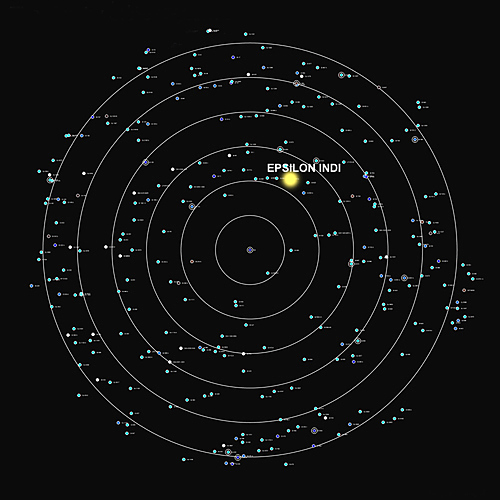
DISTANCE: 11.8 light years (lys) from Sol
NEIGHBORING SYSTEMS: Delta Pavonis 9.2 lys Alpha Centauri 9.6 lys Gliese 876 10.5 lys
EPSILON INDI is an orange-red dwarf with four planets in orbit including three small rocky worlds and one gas giant that is nearly twice the size of Jupiter. Beyond this lies an extremely dense asteroid field made up of the remnants of former planets destroyed by comets and meteors over billions of years. Two methane brown dwarfs also orbit this star at the distant edge of the system. Throughout history, these massive stellar companions disturbed the orbits of several dormant comets and asteroids, hurling them towards the star’s inner planetary regions and causing catastrophic impacts. However, these violent collisions began to decrease over time and the system has been relatively stable for the last 500 million years. The host star itself is 90 percent as enriched with heavy elements as Sol and the entire region contains huge deposits of Thaolium ore.
NUWA is the second planet in this system and is a world of fertile grasslands, warm savannas, and exotic forests with seasonal changes similar to that of Earth. 60 percent of the planet is covered by water which includes two major oceans, several small seas, and numerous tributaries which flow across the landscape. This planet also has two small moons, Zhinu and Niulang, named after the forbidden lovers in Chinese folklore.
Though no sentient lifeforms have ever evolved here, a unique variety of indigenous flora and fauna can be found on this world.
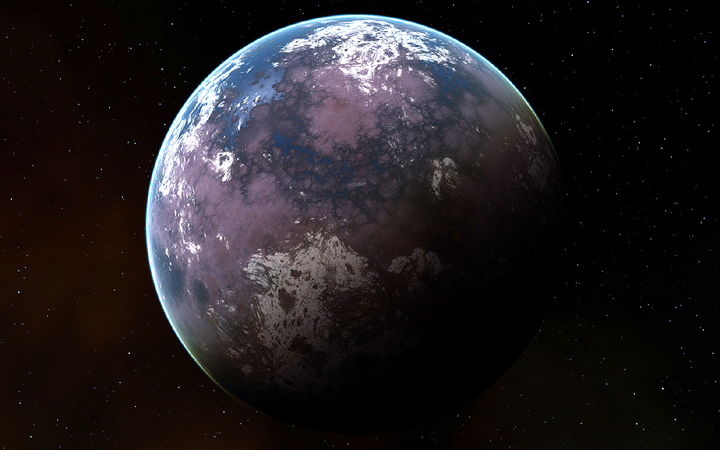
Colonized by the Lao Che Syndicate, Nuwa was found to be remarkably fertile for growing an abundant variety of indigenous fruits, grains, and vegetables. This world was immediately established as a global agricultural community and regional administrators were assigned to oversee the cultivation of designated allotments of land. In less than a decade, this colony became one of the largest exporters of food and provisions to Earth. As the need for more farmers has increased, a continuous supply of new colonists has made it the fastest growing Human colony outside of the Sol system. Even so, only a small fraction of the planet’s surface has been developed and opportunities for rich farmland are almost endless.
According to the official census of Nuwa in 2233, this planet has a population of over 12 million people living in twenty separate prefectures; the largest of which is called Shen-Nong. The colonists, consisting almost entirely of Chinese immigrants, are typically hard-working, cordial, and customarily modest. With a natural tendency towards mutual cooperation for the betterment of their society, every individual has a purpose and contributes to the community as a whole. Most of the population is made up of farmers and food distributors who operate under an almost “feudal-like” structure. These people live rather simple lives and can often be found socializing in the large open markets or taking part in the various cultural festivals that take place throughout the year.
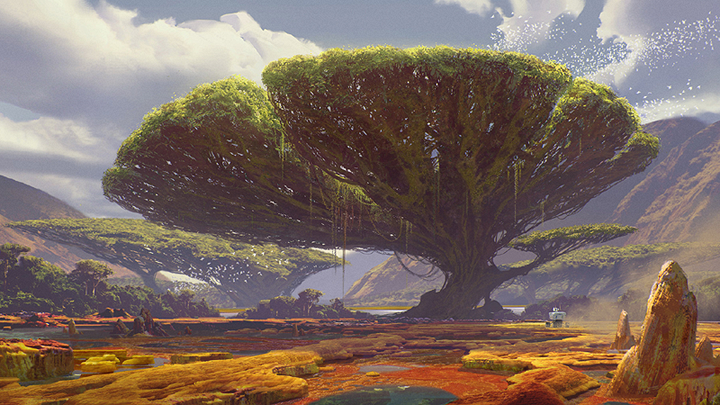
BURAN is the third planet in this system and is a frigid world covered in huge expanses of snow and ice. Even in the equatorial regions, where surface temperatures occasionally reach above freezing, the landscape is dominated by bleak grasslands, dense forests, and harsh tundra. This planet also has one large moon named Kalisfena.
Despite its bitterly cold environment, numerous warm-blooded mammals and several hearty species of birds are indigenous to this world.
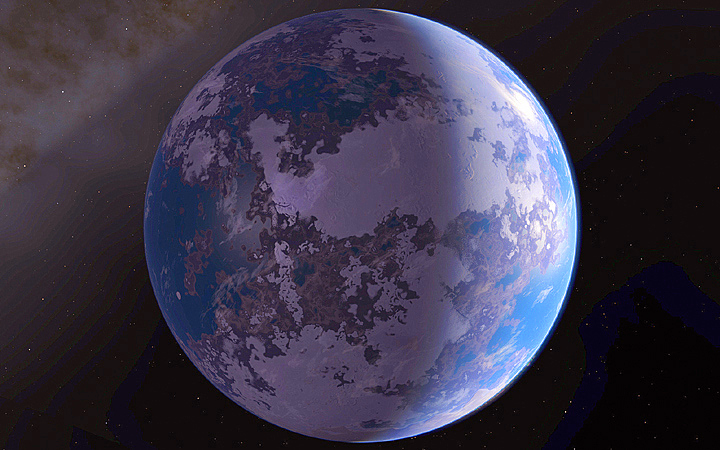
Colonized by the Zarkov Corporation, Buran is clearly visible in Nuwa’s night sky and was established as a global mining community with numerous extraction facilities scattered across the planet as well as on its large moon. In less than a decade, they had produced nearly ten billion tons of refined Thaolium ore; most of which was exported to Earth where it was utilized in the construction of SolCorp’s newest space vessels. As they have continued to expand their operations, the growing need for skilled mining technicians, ore refiners, and engineers has led to a steady increase in the number of colonists who come here for work.
According to the official census of Buran in 2233, this planet has a population of over 6 million people living in three separate cities; the largest of which is called Vasiliev. These cities have each expanded their boundaries outwards from their central cores so that nearly everyone is included in an urbanized community. The colonists, consisting primarily of immigrants from Russia, Ukraine, and Belarus, are typically well-educated, proud, and very straightforward in speaking their minds. Most of them have a long history of dealing with hardship and adversity and are highly adaptable individuals; focusing on working together towards a common goal rather than their own individual concerns. The financial success of this colony has also provided them with wealth and stability like they have never known. This new prosperity has allowed them to develop a progressive, indulgent society with a rich culture all its own. They are a very gregarious people who spend much of their free time socializing in nightclubs, participating in interactive theater performances, or simply relaxing in therapeutic spas.
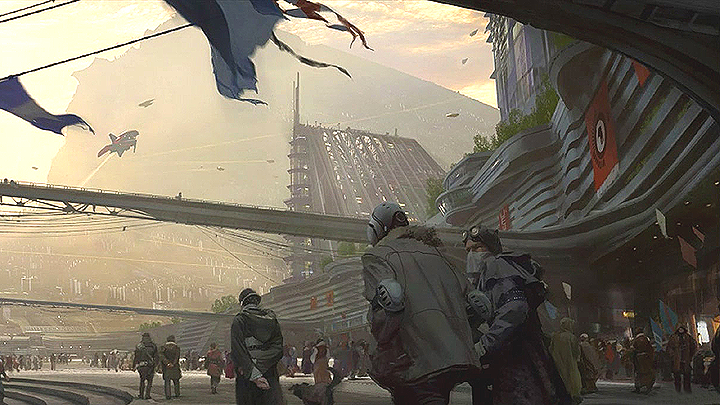
In 2154, both the Lao Che Syndicate and the Zarkov Corporation participated in a joint effort to establish Epsilon Indi as the sixth star system colonized by Humans outside of Sol. This highly successful mission was the very first interstellar project achieved by either company and was also the first system discovered with two habitable worlds orbiting the same star. Upon their arrival; the Lao Che Syndicate established its own separate colony on the planet Nuwa, while the Zarkov Corporation founded its first permanent settlement on Buran. They very quickly proved themselves to be two of Earth’s most valuable settlements and have continued to remain loyal and steadfast members of the United Earth Conglomerate.
The Indirians, as the colonists on both worlds eventually came to call themselves, have developed completely different societies of their own. Yet, they do share a much higher quality of life than if they’d remained on Earth. Because of this, they feel a great deal of loyalty towards their corporate benefactors and demonstrate their commitment through intense dedication to their work. The majority of the population believes that the goal of the UEC is the same as theirs; to come together as a unified community for the purpose of creating better worlds and improving the quality of life. However, both the Lao Che Syndicate and the Zarkov Corporation have frequently used disinformation in the media to influence public opinion or completely obscure the truth. The financial success of these companies has enabled them to gain even more power within the UEC and government officials often turn a blind eye to many of their illegal activities such as black market distribution, unregulated drug trafficking, and even occasional piracy.
By 2160, these two corporations had combined their efforts to construct the Korolev shipyard in orbit between their two planets. This industrial facility was responsible for building their own personal fleet of mining vessels, ore-haulers, and freighters which greatly increased productivity. This merger also enabled each of their private security organizations to work together on a much a larger scale. However, when the war with the Zendathu first began, the Korolev shipyard was requisitioned by SolCorp which soon began production on a new fleet of defensive battlecruisers. They also integrated both corporations’ security forces into an extension of Earth’s own military.
After the war, the Lao Che Syndicate and the Zarkov Corporation continued to maintain close political ties in the UEC. While many other colonies began to declare their independence from Earth; this system remained loyal in exchange for an increase of power and influence within the corporate empire. As the UEC began to tighten its hold on its remaining star systems, the Indirian military fleet was often assigned to provide a show of force during trade negotiations, corporate takeovers, and even the failed invasion of the Gliese 876 system. The Indirians also established a colony in the Delta Pavonis star system in 2202, officially making the third planet, Fusang, the most distant Human settlement within the UEC’s jurisdiction.